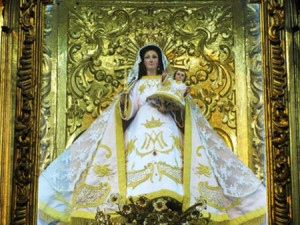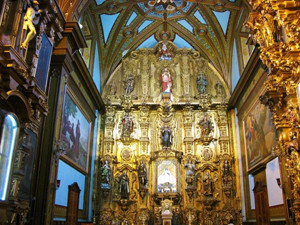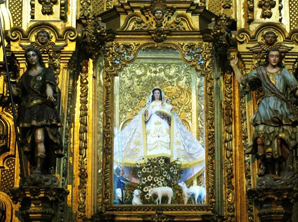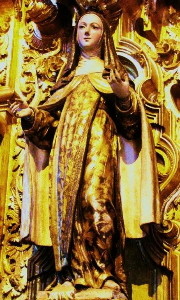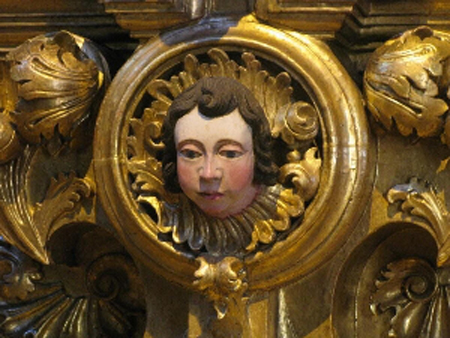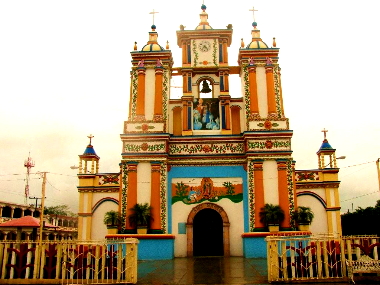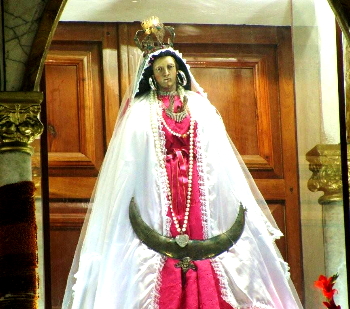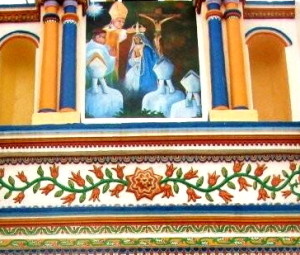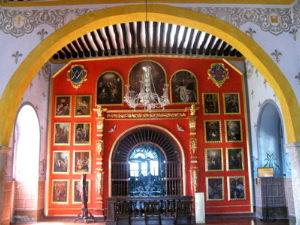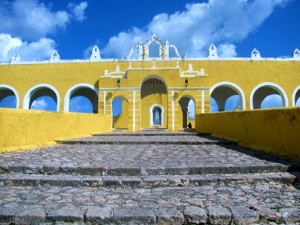Le Studio WebDesign
VISIT OUR LADY OF LORETO – Baja California Peninsula
The town of Loreto is a magnet for its “perfect” climate (average temperature is in the 80’s) and vacation activities, along with its beaches. It is also known for its famous church: the mission Church of Our Lady of Loreto, the first mission church of the Californias.
An inscription above the main portal of the church solemnly declares its primacy: Cabeza y Madre de las Misiones 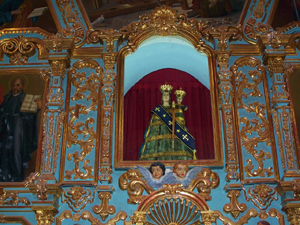 Baja y Alta California (“Head and Mother of the Missions of
Baja y Alta California (“Head and Mother of the Missions of
Lower and Upper California”). The mission is steps away from the shimmering, sapphire-blue waters of the Sea of Cortéz.
Loreto, “the oldest permanent settlement in all the Californias” is located on the eastern coast of the Baja California peninsula at the base of the Sierra de Gigante mountain range, 700 miles south of San Diego.
Loreto became the capital of Baja Sur and thus, was the first capital of the Californias.
The mission of Loreto has more claims to fame: It was the home of the Franciscan “Apostle of California” Fray Junípero Serra for a period of time. When the Jesuits were expelled from New Spain in 1767 the Franciscans were authorized to take over the 15 Jesuit-run missions on the Baja peninsula. Serra became Presidente of these missions in 1768 and the mission
of  Loreto served as his headquarters. Loreto was also the “cornerstone” and central departure point for missionary expansion northward into Alta California, Arizona, New Mexico and Texas, from which new missions and new towns and cities came into existence.
Loreto served as his headquarters. Loreto was also the “cornerstone” and central departure point for missionary expansion northward into Alta California, Arizona, New Mexico and Texas, from which new missions and new towns and cities came into existence.
The mission of Loreto was founded by Italian-born Jesuit and explorer Father Jean Marie de Salvatierra on Oct. 25, 1697. He dedicated the mission to Our Lady of Loreto for whom he had a keen devotion.(The tradition of Our Lady of Loreto commemorates the miraculous transference of the Holy House of Nazareth to the town of Loreto in Italy).
Father de Salvatierra disembarked at Baja, California, carrying the emblem of the cross and the statue of Our Lady of Loreto. He declared her queen of the expedition and Patroness of all future missions in California.
He brought his own life-sized statue of Our Lady of Loreto from Italy and described her reception by the new community: In a letter dated November 27, 1697, he wrote: “The next day we brought ashore the Holy Madonna. She was received on land with many salvos. We recited with the Indians the Ave Maria in their language and sang the litany of Loreto.
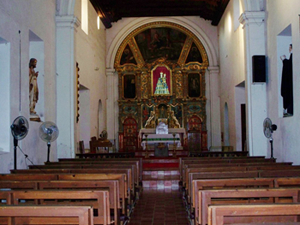 The Virgin was carried in procession, and the Indian men and women gave expression of their intense joy at the arrival of the sacred image—the tent donated by Don Domingo de la Canal was decorated as a church and on Saturday October 26 Mass was celebrated.”
The Virgin was carried in procession, and the Indian men and women gave expression of their intense joy at the arrival of the sacred image—the tent donated by Don Domingo de la Canal was decorated as a church and on Saturday October 26 Mass was celebrated.”
In 1697, the Jesuits were given authorization by the Spanish King to Christianize the Baja area. During the next 70 years they founded 14 more missions in the region. With the help of the local Guaycura Indians, construction on the first church of Loreto began in 1699. Jesuit Father Jaime Bravo initiated the building of a larger church in 1740.
The town of Loreto remained the capital and the commercial centre of the region for almost 150 years—until disaster struck in 1829: A devastating earthquake demolished much of the town. Although the church of Loreto was damaged, its basic structure, “solid, squat and simple,” remained intact.
In 1830 the capital was transferred to La Paz, a now-bustling city 210 miles south of Loreto. In 1854, diocesan clergy assumed control of the mission of Our Lady of Loreto. In 1967, Pope Paul Vl declared Our Lady the patrona principe of the Diocese of Mexicali.
A plaque in the narthex describes the church as a “magnificent temple with thick stone walls—worthy of the California capital.” Built in the shape of a Greek cross, it has a “very long rectangular floor plan somewhat out of proportion.”
The single nave, with its austere, white-washed interior and chestnut-brown cedar-beamed ceiling, is a cool and tranquil oasis from the blistering desert sun. The five-piece “very grandiose” gilded
 altarpiece, however, is anything but austere: Painted in radiant shades of crimson red and powder blue, it is adorned with an array of 3-D sculpted cherubs, angels, grapes and scrolls.
altarpiece, however, is anything but austere: Painted in radiant shades of crimson red and powder blue, it is adorned with an array of 3-D sculpted cherubs, angels, grapes and scrolls.
A statue of Our Lady of Loreto with the Infant Christ stands at the center of the altarpiece, directly above the tabernacle. Fittingly, for a shrine of Loreto, a large painting above the altarpiece depicts the Holy Family in their home at Nazareth.
The first stone church is now a chapel, situated next to the presbytery. Dominating the space is the original statue of Our Lady of Loreto. The chapel’s ambiance—white-washed walls and an altarpiece in shades of robin’s-egg blue and cream—provides a soothing retreat for the weary soul.
The museum next door is a must-see: Its comprehensive “and surprisingly sophisticated” displays recount the history of the Baja and its missions. A plaque at the entrance movingly documents the gratitude of the people of Loreto toward the founding Jesuits: “To them we dedicate this museum as a humble and respectful recognition of their courage and greatness.”
In 1769, Blessed Serra departed from the mission of Loreto and journeyed to Alta California (present-day California) where he founded a series of new missions and settlements—with names like San Diego, San Francisco, Santa Barbara and Carmel.
But the mission of Our Lady of Loreto was the first of them all.
Mary Hansen writes from North Bay, Ontario
Reprinted with permission from the NATIONAL CATHOLIC REGISTER
OUR LADY OF ARANZAZU – Guadalajara, Jalisco
It’s easy to overlook the chapel of Our Lady of Aranzazu. You could walk right by it and not even give it a second glance. The facade is austere, stark, and utterly unassuming. But step inside and you enter a different world: a masterpiece of golden Churrigueresque architecture with an “astonishingly ornate” interior. “Divine” say some. “Stunning,” say others.
The word Churriguersque comes from a family of Spanish architects and artists, the Churriguera family. They developed an ultra-baroque, highly decorative architectural style—unique to Spain and Latin America, particularly Mexico—which was popular in the early 18 th century.
Residing over the main altar is the magnificent statue of Our Lady of Aranzazu who origina
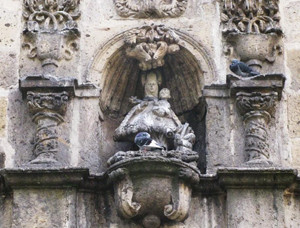 tes from the Basque region of Northern Spain. A stone statue of her can be found in its own niche on the facade above the main entrance. And this is how she got her name: Centuries ago a young shepherd was tending his flock in the remote Basque mountainside. He suddenly “stumbled upon” a most unusual sight: an image of Our Lady and Child trapped in a thicket of thorns. “ Aranzazu!” “You are in the thorns!” shouted the startled shepherd. Word spread about the discovery and the Basque people soon adopted Our Lady of Aranzazu as their official Patroness. In time the devotion was brought to New Spain (Mexico) and a Franciscan church was built in her honour by Franciscan Padre F. Inigo Vallejo with the support of wealthy Basque settlers in Guadalajara.
tes from the Basque region of Northern Spain. A stone statue of her can be found in its own niche on the facade above the main entrance. And this is how she got her name: Centuries ago a young shepherd was tending his flock in the remote Basque mountainside. He suddenly “stumbled upon” a most unusual sight: an image of Our Lady and Child trapped in a thicket of thorns. “ Aranzazu!” “You are in the thorns!” shouted the startled shepherd. Word spread about the discovery and the Basque people soon adopted Our Lady of Aranzazu as their official Patroness. In time the devotion was brought to New Spain (Mexico) and a Franciscan church was built in her honour by Franciscan Padre F. Inigo Vallejo with the support of wealthy Basque settlers in Guadalajara.
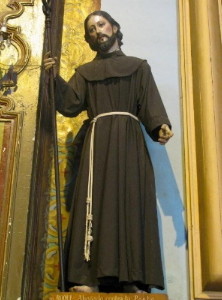 At one time the chapel was part of a vast Franciscan monastery which was several city-blocks in size. The complex consisted of the principal Franciscan church (across the road from the chapel), six chapels, a convent, a graveyard, an orchard and a huge atrium (courtyard). By 1750 the monastery’s vast motherhouse housed as many as 100 friars. It was the centre of Franciscan evangelization efforts in Western Mexico. Only two structures remain from this era, the church of San Francisco and the chapel of Our Lady of Aranzazu which was built between 1749 and 1752.
At one time the chapel was part of a vast Franciscan monastery which was several city-blocks in size. The complex consisted of the principal Franciscan church (across the road from the chapel), six chapels, a convent, a graveyard, an orchard and a huge atrium (courtyard). By 1750 the monastery’s vast motherhouse housed as many as 100 friars. It was the centre of Franciscan evangelization efforts in Western Mexico. Only two structures remain from this era, the church of San Francisco and the chapel of Our Lady of Aranzazu which was built between 1749 and 1752.
The chapel consists of one narrow nave (there used to be three) and three gilded Churriqueresque altarpieces, extravagantly adorned with wooden statues, carvings and over-sized canvas paintings.
The church was declared a national monument in 1932, a “patrimonial legacy” which had been preserved for centuries. During Mexico’s wars of Reform in the 1920’s, the church —which was used as military quarters—suffered extensive damage.
The chapel of Our Lady of Aranzazu has been described in travel books as a “splendid Baroque jewel.” An apt description. A short walk from the zocalo (the city centre), it is a must-see for any visitors to the city.
Written by Mary Hansen
OUR LADY OF CUPILCO – Cupilco, Tabasco
Tourist books rave about the church of the Assumption of Our Lady of Cupilco. They call it “the most beautiful church in the state of Tabasco.” Words such as “stunning,” “exuberantly painted” and “a gem of Mexican folk-art” complete the picture. How could I resist such a place?
And they were right. It was glorious.
What I hadn’t counted on was the rain. Torrential rain. Thunderous, pounding rain, as my taxi slogged its way through the 40-minute drive from the capital, Villahermosa. There was no rain when we left the city but the sky was a menacing mass of sombre slate-grey clouds. Five minutes out of the capital the rain began, at first only a benign pitter-patter on the windshield; then the deluge began in earnest. Psalm 77 came immediately to mind: “The clouds poured down , Your thunder rolled round the sky, Your flashes lighted up the world.” And then some.
I thought we would never make it. And this was my last chance and only chance to see such a wondrous church. I was leaving early the next morning to catch a flight to Veracruz. What a disappointment! And photos? Out of the realm of possibility, I realized now.
But make it we did. The church lived up to all expectations. It is a prime example of what is referred to as the “painted churches” of Tabasco, a style indigenous to Tabasco and two or three other states in Mexico.
The first thing you notice as you enter the church —after you revel in the extraordinary and colourful facade– is the statue of Our Lady of Cupilco: it is life-sized and stands above the main altar, over the tabernacle. She is famous in these regions: So venerated is Our Lady of Cupilco that Pope John Paul went out of his way to pay her a visit in 1999 and personally crowned the statue in a solemn ceremony. This scene is painted on the upper facade of the church, above the tableau of the apparition of Our Lady of Guadalupe to St. Juan Diego; the Guadalupe event was painted by local artist Angel Izquierdo Oructa in 1967. These vibrantly painted tableaus blend with the lavishly sculpted stucco ornamentation which decorate the rest of the facade. In the arcaded interior, columns are arrayed with relief sculptures of Our Lord with His crown of thorns and the Infant Jesus.
Every year on the feast of the Assumption, on August 15, the statue is taken from its position above the main altar and is processed through the town accompanied by throngs of devotees. Hymns, prayers, rosaries, flowers, candles, bands—all are part of the festive celebration.
According to tradition, the statue (known as Our Lady of the Assumption) was discovered by fishermen in 1634. It was found in a rowboat on the shores of a nearby lagoon and then taken to the church in Ayapa. All noticed a strange phenomenon: several times at night the Virgin would change position— She would turn to face the town of Cupilco! Church officials, realizing that the statue wanted to be in Cupilco, moved it there where it has resided ever since. Although there has been a church in Cupilco since Colonial times, the existing one is relatively new; it was built in the early 1900’s.
In the photo gallery on this webpage you will see another example of a “painted” Tabasco church: this is the blue and white church in the next-door town of Mecoacan Ayapa.
The state of Tabasco experiences unusually high amounts of rainfall. Flooding is not uncommon. In 2007 a major flood affected over a million people and 80% of the state when the Grijalva river overflowed its banks. In some areas water levels rose to four metres. During my bus trip from Campeche through Tabasco I noticed extensive flooding as well (although not of the severity of the 2007 floods)—much of the farmlands resembled rice paddies. In low-lying areas I saw cars almost totally submerged, and cattle and horses standing chest-high in muddy-coloured waters. It was an unforgettable and surreal landscape. Parts of the state—but not Villahermosa—had been declared a disaster area.
Our Lady of Cupilco is known for her miraculous powers of intercession. Major miracles. Minor miracles. Everday miracles. And the photos? Against all odds—they “turned out.”
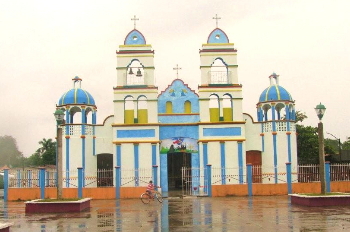

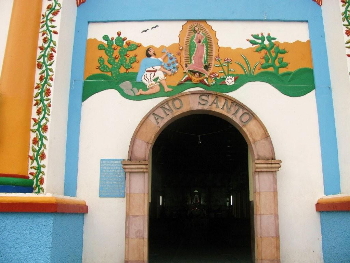
Written by Mary Hansen
OUR LADY OF IZAMAL Izamal, Yucatan
The Yucatan. To sun-starved northerners the very name conjures up images of Caribbean beaches, a turquoise sea and ancient Mayan ruins. Lots of them. The Yucatan Peninsula is reputed to have one of the richest stores of archeological treasures in the world. It is populated by the Maya, the most populous indigenous group in North America. Multitudes of Canadians and Americans visit every year.
If one can tear oneself away from the beaches, a prime location for the exploration of such ruins is the scenic town of Izamal. It is situated in the heart of the Yucatan Peninsula, 270 km. west of Cancun and a 40-minute drive from the state’s capital, Merida. Considered the oldest and most beautiful town in the Peninsula, Izamal was one of the major Mayan worship sites of pre-Hispanic times.
As interesting as the ruins are, the “top attraction” in Izamal (according to travel guidebooks) is the “magnificent” Franciscan convent of St. Anthony of Padua. Its origins go back to 1533. It was one of the first monasteries in the western hemisphere and became a centre of evangelization for the whole peninsula.
The enormous complex (church, atrium and convent) is one of the largest of its kind in America and was built upon the platform of the immense temple, Pap-Hol-Chac, a ceremonial centre dedicated to the Mayan god of rain.
The Franciscans realized the religious significance of the location: Izamal had been the headquarters not only for the Mayan priesthood, but for the worship of the supreme Mayan god, Kinich-Kakmo. Under the direction of Franciscan founder, Fray Diego de Landa, most of the Pap-Hol-Chac pyramid was demolished and its stones were used for the building of the new monastery, thus “sanctifying a place that had been one of abomination” (human sacrifice had been practiced there). Another massive pyramid in the town, Kinich-Kakmo, the second largest in the state, was built between 400-600. Partially restored, it is a five-minute walk from the monastery.
The late Blessed Pope John Paul ll visited the convent in 1993. He chose it as the meeting place for his encounter with the indigenous peoples of Latin America. A statue of him in the courtyard (as well as a small museum in the convent) commemorates the event.
 The atrium of the world-famous convent is reputed to be the second largest in the world, after St. Peter’s in Rome. The grass-covered courtyard is surrounded by 75 distinctive arches. The structure is painted a vibrant yellow; in fact, the entire town is painted this colour. It is known in travel brochures as “The Yellow City.”
The atrium of the world-famous convent is reputed to be the second largest in the world, after St. Peter’s in Rome. The grass-covered courtyard is surrounded by 75 distinctive arches. The structure is painted a vibrant yellow; in fact, the entire town is painted this colour. It is known in travel brochures as “The Yellow City.”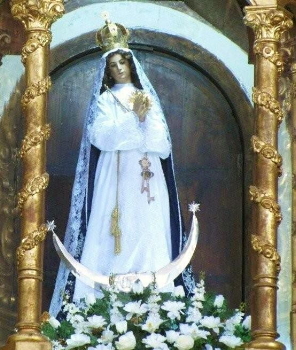
The monastery’s principal church is the Sanctuary of the Virgin of Izamal, dedicated to the Immaculate Conception. It is the most important Marian shrine in the Yucatan Peninsula (which encompasses three states: Quintana Roo to the east with its 200 km of Caribbean coastline, Campeche to the west and Yucatan state to the north).
The famed statue of Our Lady of Izamal, named Queen and Patron of the Yucatan, was commissioned by Fray de Landa in Guatemala (the centre for religious art in the New World) in 1558 and is enshrined in the church. The lavishly painted camarin(dressing-room of the Virgin, a feature of Marian shrines in Mexico) is said to be the oldest in the country. It is in sharp contrast to the nave of the church which is in an austere, typically 16 th century Franciscan style.
Read almost any description of Izamal and its convento and you are sure to notice one thing: superlatives abound. Sometimes such guides are known to exaggerate. In this case they do not.
Written by Mary Hansen
This article is reprinted with permission from the CATHOLIC REGISTER
Pope Benedict’s historic trip to Mexico
This month the MADONNAS OF MEXICO website features a preview of
Pope Benedict’s historic trip to Mexico.
MEXICO’S MUST-SEE MARVELS
Pope Benedict’s March trip, his first to Mexico, will include a stop at El Cubilete. To those outside Mexico, it seems like an obscure choice. Mexicans, however, are not surprised at all: El Cubilete is considered the second most important religious site in the country.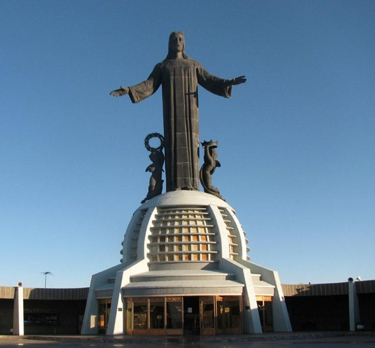
Pope Benedict will celebrate Mass at the foot of El Cubilete Hill, the site of the colossal statue of Cristo Rey (Christ the King). With its height of 9,000 feet, El Cubilete looks much more like an imposing mountain than a hill. The statue was declared a national monument in 1928.Cristo Rey can be compared to Poland’s ark church of Nowa Huta, the major symbol of Catholic Poland’s resistance to the anti-religious Communist regime of the Cold War years. Blessed Pope John Paull ll (then Cardinal Karol Wojtyla) laid the first cornerstone for the church in 1969.
Referring to El Cubilete, former Mexican President Vincente Fox said that Cristo Rey serves as a “rebuke to the repressors of religious freedom.” The dramatic history of the statue parallels that of Mexican Catholics in the brutal religious persecution of the 1920’s and 30’s, a time when government forces executed thousands of Catholics and scores of Catholic priests.
The 75-foot, 200-ton statue of Cristo Rey stands majestically atop the hill, his arms extending in a panoramic blessing on the valley below. Known as the “Christ of the Perpetual open Arms,” it rests on a concrete hemisphere that represents the universe. Two angels kneeling in adoration present crowns—one of thorns, one of majesty—to their King. The location is powerfully symbolic, too: According to the National Geographic Commission of Mexico, El Cubilete is the geographical midpoint of the country—Christ reigns, therefore, from the very heart of the Mexican nation.
The first of the Cristo Rey statues (there have been five) was built in 1920; 20,000 people attended the opening ceremony, and 80,000 (in defiance of the government) attended the ceremony for the blessing of the first stone of the second monument in 1923. This one was never constructed, however; it was declared “unconstitutional” and was forbidden by the state. In 1928, government forces dynamited the original statue, reducing it to a pile of rubble. Inexplicably, the heart and head of Jesus survived the disaster, undamaged and intact. Undeterred, the Mexican people built a third statue in 1937, this time hidden from the authorities. It is known as “The White Christ” (considerably smaller than the first one). Today it reposes in the Cathedral of Leon, where Pope Benedict will celebrate vespers on March 25. The last statue was built in 1944.
The Cathedral of Leon (the fifth largest city in Mexico) is also the home of the miraculous painting of Our Most Holy mother of the Light, the patrona (patroness) of the city and the diocese. The great cathedral was built by the Jesuits in 1746. The small image, which originated from Italy, hangs above the main altar. It is one of the most recognized patronages of Our Lady in Mexico; pictures of her can be found in churches throughout the country. They depict Our Lady, enveloped by light, saving sinners from hell. The Infant Jesus, cradled in her arms, blesses hearts. (Please note: this cathedral is described in the September 2011 Shrine archives of the MADONNAS OF MEXICO website.)
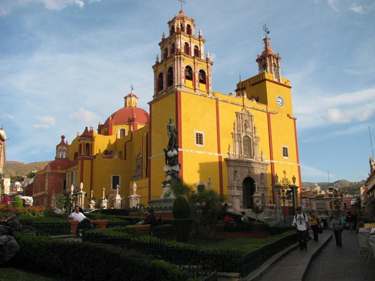
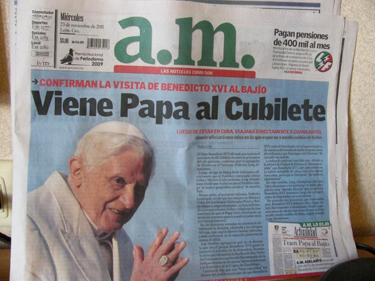
My personal favorite on Pope Benedict’s itinerary is the city of Guanajuato. On March 24, the Holy Father will bless the faithful at La Paz Square in the beautiful mountain city, a “colonial gem” lauded by travel writers. Declared a UNESCO World Heritage Site in 1988, the college town—the University of Guanajuato has 40,000 students—exudes a cheery vitality. It is a city of steep inclines, cobblestone streets, narrow alleyways, crayon-bright colonial buildings and flower bedecked outdoor cafes. Directly in front of the square is the 17 th -century Basilica of Our Lady of Guanajuato, an elegant, neo-classical church. It is a fitting home for the much-venerated statue of Our Lady of Guanajuato, the patrona of the city. The statue is reputed to date from the seventh century. It is believed to be one of the oldest Christian images in the Americas; the statue was a gift from the Spanish King Charles V in 1577 to the Mexican people in thanks for the treasures that poured into Spain’s coffers from the Guanajuato silver mines. It had been hidden in Spain for centuries during the occupation of the Moors and was rediscovered in the city of Granada in 1492.
The basilica is my hands-down favorite in the city. You open its doors and step into a sanctuary of utter serenity: A froth of pastel tones—lemon yellow, powder blue, rosy peach—permeates the striking interior. Lights shimmer from dozens of Venetian crystal chandeliers overhead. A bevy of statues and paintings grace the airy, light-filled space.
Pilgrims to these destinations will see what the Pope will—the beauty and history of Mexico’s Catholicism.
Written by Mary Hansen National Catholic Register correspondent,
This article is reprinted with permission from the NATIONAL CATHOLIC REGISTER
The Church of La Candeleria, Tlacotalpan, Veracruz
FEAST OF THE PRESENTATION: February 2
Riverboat Procession: OUR LADY OF THE CANDLES
THE CHURCH OF LA CANDELERIA
Tlacotalpan, Veracruz
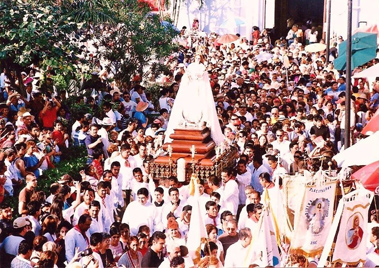
Tlacotalpan is one of the prettiest towns you could find anywhere. Located on the banks of the Papaloapan River, it is 50 miles southeast of the city of Veracruz. With its vibrantly painted houses in tones of aqua, lime green, rose pink and yellow, it is picture-book perfect.
The powder blue church of La Candeleria is framed by palm trees and the brilliantly blue tropical sky. Like all colonial churches in Mexico, it stands at the centre of the town, overlooking the zocalo
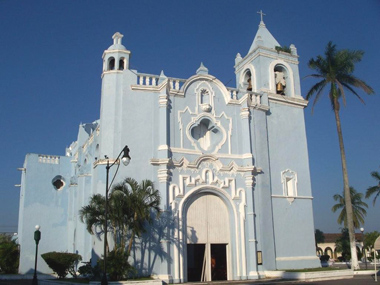 (the town plaza). It is not surprising that UNESCO declared the town a World Heritage Site in 1998, citing its “fusion of Spanish and Caribbean traditions” and “exuberant styles and colours.”
(the town plaza). It is not surprising that UNESCO declared the town a World Heritage Site in 1998, citing its “fusion of Spanish and Caribbean traditions” and “exuberant styles and colours.”
But Tlacotalpan was famous long before 1998: As far back as anyone can remember, it has been renowned for its unique celebration of the Feb. 2 Feast of the Presentation. Instead of the customary procession of the statue of Our Lady through the highways and byways of a town, in Tlacotalpan, the procession takes place on the river, accompanied by hundreds of fishing boats, lanchitas (motorboats) and serenadingMariachi bands. Throngs of well-wishers and Marian devotees follow along in rented boats or line the banks of the river to pay homage to their beloved Virgin, the patrona of the town. According to the book, Santuarios Marianos Mexicanos, the river procession is “magnificent” and “unique in the world.” Others have called it a “marvellous spectacle.”
It is entirely fitting that such a celebration takes place on the river: “Tlacotalpan” in the Nahuatl language means “place between the rivers,” and from pre-Hispanic times, the Papaloapan River has played a central role in the lives of the town’s inhabitants. The river has not always been benign, however; it frequently overflowed its banks, causing “deadly” flooding. It was at these times that Our Lady’s protection was particularly invoked. It is believed that this was the origin of the river procession: that Our Lady would bless not only the waters and the fishing but all of the people in its wake.
The adult-sized statue of La Candeleria was a gift to the people of the town in 1776 from the Spanish hacienda owner, Pascual de Ovando Rivadenyra. It origi
 nated from Spain. So appealing was this statue that it became the impetus for the rebuilding of the present-day church of La Candeleria which was completed in 17 79 .
nated from Spain. So appealing was this statue that it became the impetus for the rebuilding of the present-day church of La Candeleria which was completed in 17 79 .
Almost 200 years old, the statue’s face and expression are those of a “modern-day” young woman. She looks not at all ethereal, but like someone you could meet at the local supermarket any day of the week. The tall, slender figure has enormous, expressive eyes and delicate facial features, with just the hint of a smile. And something else: Our Lady is holding her Infant Son in a manner different from other statues—it is as though she is presenting Him to the world, tous in the pews, or to the Lord. Which is appropriate: this, after all, is what the Feast of the Presentation is all about.
The festivities in Tlacotalpan take place over a period of days. Bands, fireworks, symphony orchestras, Fandango dances, theatre groups, and the “running of the bulls” are all part of the celebrations. But February 2 is the focus of it all; At dusk on this day, La Candeleria is escorted from her sumptuously elegant church to the wharf; there she begins her annual pilgrimage on the waters. Thousands of candlelights flicker through the night sky as the Virgin glides serenely down the river, bestowing her blessings on all . Candles have been associated with the Feast of the Presentation for centuries. They symbolize Christ as the Light of the world.
Spanish poet Julio Sesto wrote these words after visiting Tlacotalpan: “Oh, my brother, if you are weary of suffering, go to the Papaloapan—everything is cured in Tlacotalpan, everything is forgotten.” Where Our Lady of the Candles ( La Candeleria) is always ready to lend a helping hand.
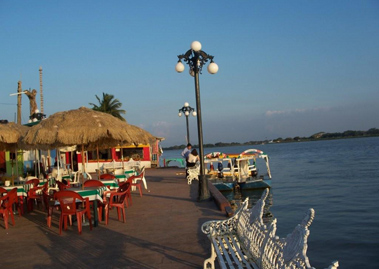
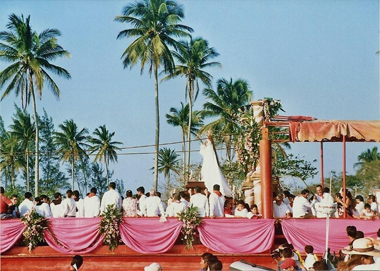
Written by Mary Hansen
This article is reprinted with permission from the NATIONAL CATHOLIC REGISTER
Basilica of Our Lady of Guadalupe – MEXICO CITY
The year was 1531. And times were desperate indeed for the small group of Spaniards in New Spain (present-day Mexico). They were outnumbered 600 to one by the Aztecs and a massacre seemed imminent. Tensions were at a fever pitch because of the tyrannical behaviour of a few of the Spanish secular leaders. Franciscan Juan de Zumárraga, the first bishop of Mexico City, realized that only a miracle could save the perilous situation.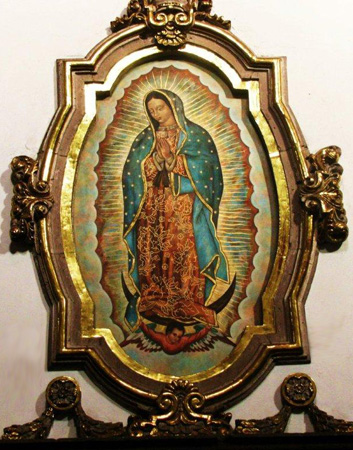
On the morning of Dec. 12, 1531, Juan Diego appeared yet again at the bishop’s door. The bishop was astonished when he realized that Juan was carrying a large assortment of roses. “At this time of year! Impossible!” he said to himself. “And Castilian roses at that!” This was the sign that he had been secretly praying for. But this was just the beginning: When Juan removed his cloak a portrait of Our Lady of Guadalupe as an Aztec maiden appeared on its surface. Bishop Zumárraga fell to his knees in wonder before the miraculous image. As would multitudes of believers throughout the centuries to the present day.The Basilica of Our Lady of Guadalupe in Mexico City (which houses the image) is the most visited Marian shrine in the world, attracting an estimated 20 million pilgrims a year, far surpassing the number of visitors to Lourdes and Fatima.
The New Basilica was built in 1976 and stands alongside the Old Basilica which is now used as a museum. It was declared unsafe due to its sinking foundations in the sandy subsoil of Mexico City.
Far from waning, the popularity of Our Lady of Guadalupe seems to be ever-increasing. An official from the Mexico City tourist bureau reported that, on average, seven million pilgrims attend the Basilica annually for the Dec. 12 feast day festivities. And, an astonishing 12 million people ( according to the Financial Post , Aug. 2, 2002) lined the streets of Mexico City to greet Blessed Pope John Paul as he entered the city for the canonization of Juan Diego in 2002.
Images of Our Lady of Guadalupe are found everywhere in Mexico: In buses. Taxis. Bus stations. Parks and shopping malls. There is even a picture of her in the McDonald’s restaurant in the city of Puebla! It is no wonder that she is called the “national icon” of the Mexican people.
The preservation of the tilma (Juan Diego’s cloak) is an ongoing miracle in itself. The 480-year- old image, imprinted on the delicate fibres of the Maguey plant, should have disintegrated within 20 to 40 years. Inexplicably, the fabric is perfectly intact and the colours are as radiant as if they had been freshly painted. Extensive scientific investigations have been carried out on the image: Studies in the field of astronomy indicate that the stars on Our Lady’s mantle coincide with the constellations in the sky on the night of Dec. 12, 1531; recent studies in advanced computerized technology in the area of ophthalmology reveal that several figures can be seen reflected in Our Lady’s eyes, among them, Juan Diego and Bishop Zumárraga; further scientific studies have found that the “colours” in the image are unknown to science, being of “neither animal, vegetable or mineral origin.”
The appearance of Our Lady of Guadalupe dramatically changed the face of the North American continent. Human sacrifice (which had been practised on a widespread scale) was finally abolished. Today, Our Lady of Guadalupe is patroness of the pro-life movement. Millions were converted to the Christian faith within a decade and peace was established between the Spanish and the Aztecs in central Mexico. It was she, Our Lady of Guadalupe, who brought them together. Renowned Mexican novelist, Carlos Fuentes, says that Our Lady of Guadalupe is the central unifying force of the Mexican people.
Her unforgettable words to Juan Diego are inscribed above the main entrance of the Basilica: No estoy yo aquí que soy tu Madre?—“Am I not here? I who am your Mother?”
Who can resist such a message?
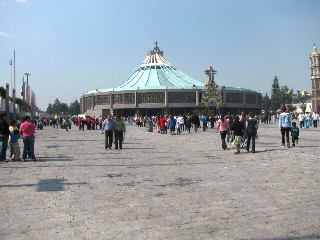
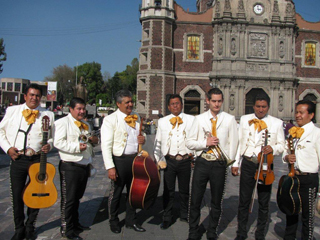
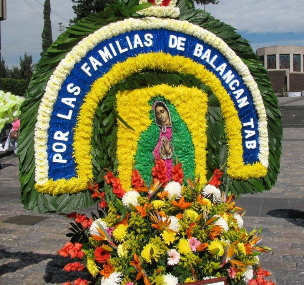
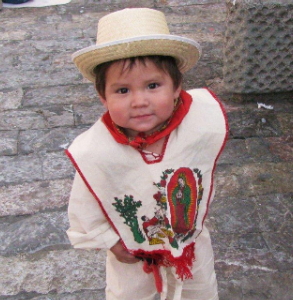
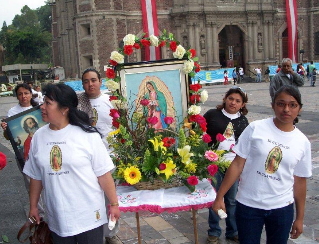
Written by Mary Hansen
Reprinted with permission from THE CATHOLIC REGISTER
Our Lady of Monterrey, Monterrey, Nuevo Leon
The city of Monterrey was founded in 1596 by Spanish official Diego de Montemayor and he named it in honour of Our Lady: La Ciudad de Nuestra Senora de Monterrey , Our Lady of Monterrey City.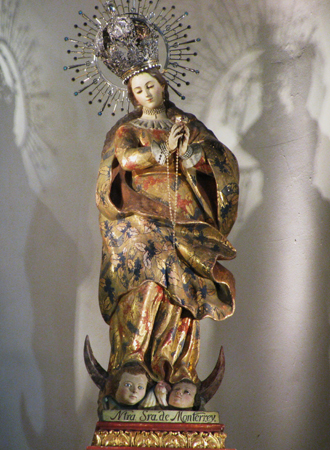
Monterrey, the third largest city in Mexico, is a prosperous and bustling city of three million inhabitants, known for its state-of-the-art technology. Only three hours from the Texas border, it is the most Americanized of Mexican cities. The city is surrounded by the rugged Sierra Madre Oriental mountains and is dominated by the Cerro de la Silla ( “the hill of the saddle” ), a craggy, distinctively-shaped mountain peak which is visible to all. It has become the city’s emblem.
Monterrey’s central plaza is one of the largest in the world, more expansive than Red Square, St. Mark’s Square or thezocalo in Mexico City: It is the result of an urban renewal program in the 1980’s in which scores of downtown buildings were demolished to create a new “space.” And—it worked! It is beautiful—a green oasis graced by fountains, monuments and historic city buildings. The “plaza” is not, indeed, a square: called the Macro Plaza, it is an elongated “park,” six city-blocks-long and almost one hundred acres in size. At one end of the plaza is the “resplendent” 18 th century Cathedral of Monterrey, home to the adult-sized exquisite statue of Our Lady of Monterrey.
Her origins are sketchy: Many believe that the ancient statue was based on the image of Our Lady of Monterrey which is venerated on the major altar of the Cathedral in Monterrey in Galicia, Spain. To celebrate the Marian Year of 1954, Mexican Archbishop Espino y Silva decreed that the statue be restored “in a style which completely duplicates its primitive appearance.” This mission was accomplished—and is apparent to the visitor to the Cathedral to the present day.
Blessed Pope John Paul ll visited the Cathedral in 1990 and prayed before the image. A round tile depicting his familiar papal shield was placed in the floor of the Cathedral to commemorate the event. To celebrate the 400 th anniversary of the foundation of the city of Monterrey, Cardenal Suarez Rivera crowned the image of Our Lady of Monterrey with papal authorization. Which is only fitting: After all, the city was named after her!
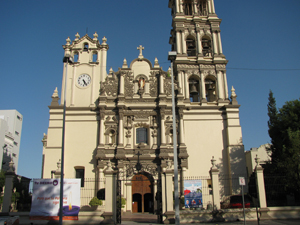
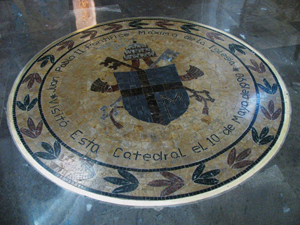
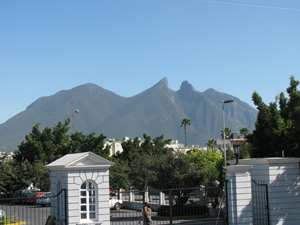
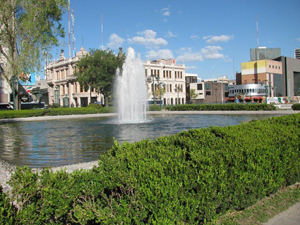
Written by Mary Hansen
Our Lady of the Rosary, Puebla, Puebla
CHAPEL OF OUR LADY OF THE ROSARY
Church of Santo Domingo, Puebla, Puebla, Mexico
In the Catholic world the month of October is dedicated to the Rosary. The feastday of the Rosary (October 7 th ) was instituted by Pope St. Pius V in 1571 to commemorate the victory of the Christian forces in the battle of Lepanto on October 7, 1571. The Pope attributed this totally unexpected victory to the power of the Rosary. In a recent address at the Basilica of St. Mary Major in Rome, Pope Benedict XVl said that the Rosary “is not a pious practice banished to the past;” it is, instead, “experiencing a new Springtime.”
Throughout the world one finds a multitude of chapels and churches dedicated to the Rosary. One of the most “sumptuous” is the Chapel of the Rosary in the Church of Santo Domin
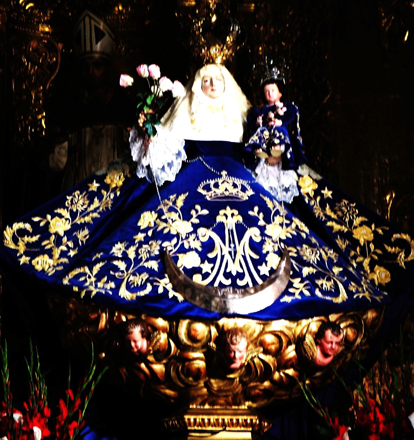 go (St. Dominic) in the historical centre of the city of Puebla, Mexico. Puebla, in central Mexico, is the fourth largest city in the country.
go (St. Dominic) in the historical centre of the city of Puebla, Mexico. Puebla, in central Mexico, is the fourth largest city in the country.
A description of the Chapel from a University of Puebla publication refers to it as “the 8 th wonder of the world.” Anything described as the 8 th wonder of the world must be worth seeing! And, in this case, it is. Travel guidebooks also rave about it: Footprint’s Guide to Mexico says it is “one of the most stunning sights in Puebla,” no small feat in a city which proliferates in “splendid” colonial-era churches, homes and public buildings. Colonial Mexico calls the chapel a “baroque gem” which should not be missed. Other books portray it as a “masterpiece.”
Known as the “house of gold” it is considered the city’s most ornate chapel—with its walls and ceilings lavishly covered in “gold leaf and gilded statues, angels and flowers.” Paintings of the Mysteries of the Rosary line the walls of the chapel and Talavera tiles (colourful ceramics unique to Puebla) provide the wainscoting. Construction on the Chapel began in 1650.
The Dominicans arrived in Puebla from Spain in 1532 and promptly began work on this church dedicated to St. Dominic. Tradition relates that the Rosary as a type of prayer was given to St. Dominic by Our Lady, herself, in the twelfth century. The Church was completed in 1571. As in all churches of the Dominican Order, it is not St. Dominic who holds centre-stage: It is Our Lady of the Rosary (after Our Lord, of course). Here in Puebla, she resides in splendour on her onyx-pillared “throne” in the golden Chapel of the Rosary.
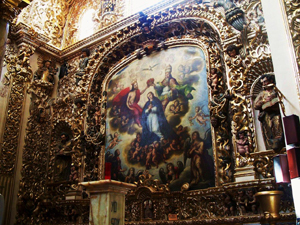
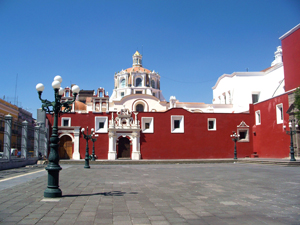
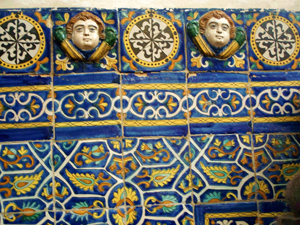
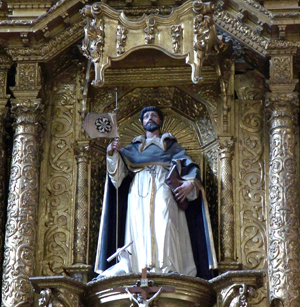
Written by Mary Hansen
Our Lady of Ocotlan – “The Lourdes of Mexico”, Tlaxcala, Tlax.
In 1531 Our Lady of Guadalupe appeared to Juan Diego in Mexico City and left her miraculous image on his cloak. It was a spectacular apparition and resulted in the conversion of millions to the Christian faith.
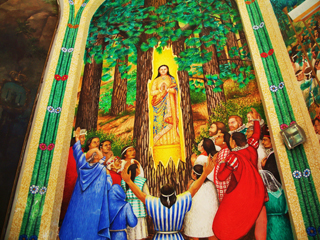
Ten years later—10 th anniversaries are always significant—a second spectacular apparition occurred in Mexico: that of Our Lady of Ocotlán.
In 1541, the city of Tlaxcala (an hour and a half east of Mexico City) was devastated by a smallpox epidemic in which 90% of its citizens died. Tlaxcalan Indian Juan Diego Bernardino worked at the nearby Franciscan convent—the first to be established in the country. On Feb. 27, 1541, he was out fetching water for his sick relatives. He was utterly astonished when a “beautiful lady” appeared directly in his path. She spoke of a miraculous spring that would cure everyone of their illnesses. “I will help all who are suffering,” she promised. Sure enough, all who drank the water were cured. Within days, the epidemic had vanished. But that wasn’t all—
The “beautiful lady” had also given him a message for the Franciscan friars: “Tell the monks that they shall find an image of me—through it I will bring forth my blessings.” The friars were skeptical: Where would they find such an image? And did such a thing even exist?

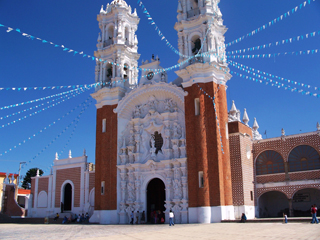 By a series of mysterious signs, however, their attention was directed to one particular tree. The friars had been shocked by two strange events: Not only was the forest on fire, but one particular tree was not being consumed by the flames. Once the fire dissipated, they proceeded to investigate: When the friars took an axe to this tree—in the presence of a multitude of witnesses—they discovered a wooden statue of the Blessed Virgin inside the tree trunk. All fell to their knees in awe and wonder.
By a series of mysterious signs, however, their attention was directed to one particular tree. The friars had been shocked by two strange events: Not only was the forest on fire, but one particular tree was not being consumed by the flames. Once the fire dissipated, they proceeded to investigate: When the friars took an axe to this tree—in the presence of a multitude of witnesses—they discovered a wooden statue of the Blessed Virgin inside the tree trunk. All fell to their knees in awe and wonder.
The statue, almost five feet tall, was carried in joyous procession to the church where it resides today above the main altar in the shrine of Our Lady of Ocotlán.
The apparition has received the approval of the Church at the highest levels: Five popes have expressed belief in the authenticity of the 1541 miracle, from Pope Clement Xll in 1735 to Pope Pius Xll in 1941. In 1755 she was declared the Patroness of Tlaxcala. Later, the shrine was elevated to the status of a basilica. In 1906 the Holy See authorized the liturgical crowning of the image of Our Lady of Ocotlán.
It is not surprising that the Tlaxcalans should be so favoured: They played a pivotal role in the Spanish Conquest, allying with the vastly outnumbered Spaniards against the mighty Aztec warriors. Bernal Diaz, in his firsthand account, The Conquest of Mexico,describes the Tlaxcalans as “fervently loyal.” They were not only the first “friends” of the Spaniards in the New World, they were also its first Christians. The first diocese in the country was established here in 1526.
Travel writers call the church “stunning” and describe it as “one of the most beautiful churches in Mexico.” Historians cite it as a “masterpiece” of the late Mexican-Baroque style of architecture known as Churrigueresque, named after the Spanish architect, Benito de Churriguera, who dominated Spanish architecture for the first half of the 18 th century.
In Mexico this architectural style intensified and reached its most striking and elaborate expression. The purpose of such design was not frivolity: rather, it was to give effusive and exuberant praise to God. The single-naved basilica is a profusion of gold! Everything seems to be decorated in an array of gilded, richly carved swirls, scrolls, flowers, grapes, shells, vines and garlands. The twin-towered church façade features hexagonally-shaped red bricks combined with brilliant white stucco ornamentation.
Pilgrims to the shrine can also pay a visit to the Capilla del Pocito which houses the miraculous well. Here, in the charming blue and white octagonal chapel, they can obtain the same healing water that cured the townspeople of the smallpox epidemic so many years ago.
Other miracles abound: During a 1987 celebration Bishop Luis Munive Escobar of Tlaxcala witnessed changes in the colour of the statue’s face, a phenomenon observed by many visitors to the shrine.
“Are there healing miracles going on today?” I asked the sister in charge of the chapel. “Oh, yes!” she said, “but far too many to recount. But why should we be surprised? Our Lady always keeps her promises!”
Written by Mary Hansen
This article is reprinted with permission from the NATIONAL CATHOLIC REGISTER
